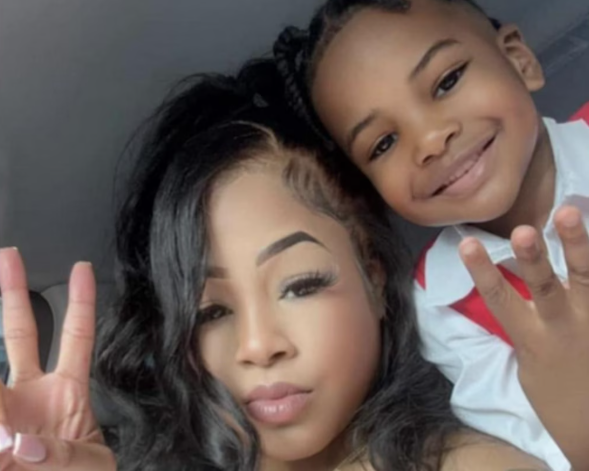
 Arkia “Kia” Berry, 28, her son, 5-year-old Landyn Brooks and Berry’s boyfriend, 28-year-old Eric Ashley Jr. were gunned down Saturday, July 13, 2024, at the entrance of Echo Highlands Park on Birmingham's east side. (Contributed)
Arkia “Kia” Berry, 28, her son, 5-year-old Landyn Brooks and Berry’s boyfriend, 28-year-old Eric Ashley Jr. were gunned down Saturday, July 13, 2024, at the entrance of Echo Highlands Park on Birmingham's east side. (Contributed)By Alaina Bookman | abookman@al.com
This is another installment in the series “Beyond the Violence.”
Amid the deadliest year of Birmingham’s history, firearms remained the leading cause of death for Alabama children and teens, according to a recent Johns Hopkins Center for Gun Violence Solutions study based on data from the Centers for Disease Control and Prevention.
Birmingham ended 2024 with 151 homicides, breaking the city’s all-time homicide record. Of people killed in 2024 in Birmingham, 10 were children, with the youngest being 5-year-old Landyn Brooks.
“The prevalence of youth violence does not make it normal,” said TeAndria Ellis, founder and executive director of the Surge Project, a Birmingham nonprofit dedicated to youth and community development.
Most recently, 17-year-old Gerald Andre Lomax Jr., a Jackson-Olin athlete said to always have a smile on his face, died after he was shot in front of Woodlawn High School in November.
The other nine children’s names are: Aston Starkey, 13; Markell Sanders, 15; Prentice Lovell Little, 15; Cornelia Rose Lathan, 15; Jaylin Lee Jenkins, 16; Alexis Elizabeth Wise, 16; Jaquavius James Weston, 18; and Jonathan O’Dell Thomas Jr., 18.
Many children also have been injured in shootings.
In the United States in 2022, there were 2,526 gun deaths among 1 to 17-year-olds, averaging nearly seven per day.
Gun death rates in this age range have increased by 106% since 2013 and have been the leading cause of death among children since 2020, according to the report.
Black children and teens are disproportionately impacted by gun violence. In 2022, Black children ages 1 to 17 had a gun death rate 18 times higher than that of white children in the same age group. And among deaths of Black teens between the ages of 15 to 17, more than half, 55%, were killed by guns.
“Communities that experience high rates of gun violence are just absolutely ravaged by this issue, and it has long, long-standing effects,” said Cassandra Crifasi, co-director of the Johns Hopkins Center for Gun Violence Solutions and one of the authors of the report.
Stricter Gun Laws
Experts say there are ways to curb the violence.
Authors of the Johns Hopkins report recommend implementing firearm licensing that includes background checks and required safety training, removing firearms from those at risk of harming themselves or others, repealing stand-your-ground laws and more stringent permitting for open and concealed carrying of firearms.
In 2023, Alabama made it legal to carry a concealed handgun without a permit. While Alabama is not known for its strict gun laws, many GOP lawmakers and law enforcement personnel have recently begun to back stricter laws amid a local rise in gun violence.
Experts say gun violence drains communities of resources and can perpetuate a cycle of fear and uncertainty throughout the community.
Crifasi said stricter gun laws and expansion of public health responses like community violence intervention programs are proven methods of curbing gun violence and improving communities.
Birmingham community members and local officials have launched several initiatives to curb violence, including the Hospital Linked Violence Intervention Program at the University of Birmingham Hospital, Jefferson County’s RESTORE program to help at-risk youth get back on track and the Common Ground program which teaches elementary to high school students about conflict resolution.
“I believe when you give people the resources that they need to pull them out of survival mode, where they can thrive, you will start to see reductions in gun violence in the city of Birmingham,” Ellis told AL.com. “The power to transform communities lies within the community.”
Stephanie Hawkins, vice president of the Transformative Research Unit for Equity at RTI International, a nonprofit research organization, said at-risk youth are vulnerable to falling through the cracks and are hard to reach unless there are explicit, intentional strategies to find them and provide tailored support.
Hawkins said community investment in schools, transportation, clean water, violence intervention programs, job opportunities and representation of diverse voices in community violence prevention research and policies are all vital to making positive changes.
“When young people have to navigate life with the reality that their family member, friend is potentially going to die from violence…that trauma and grief is really profound and sometimes not tended to, so making sure that there is a trauma informed, culturally responsive approach on top of structural changes is important,” Hawkins said.

 2 days ago
3
2 days ago
3









 English (US)
English (US)